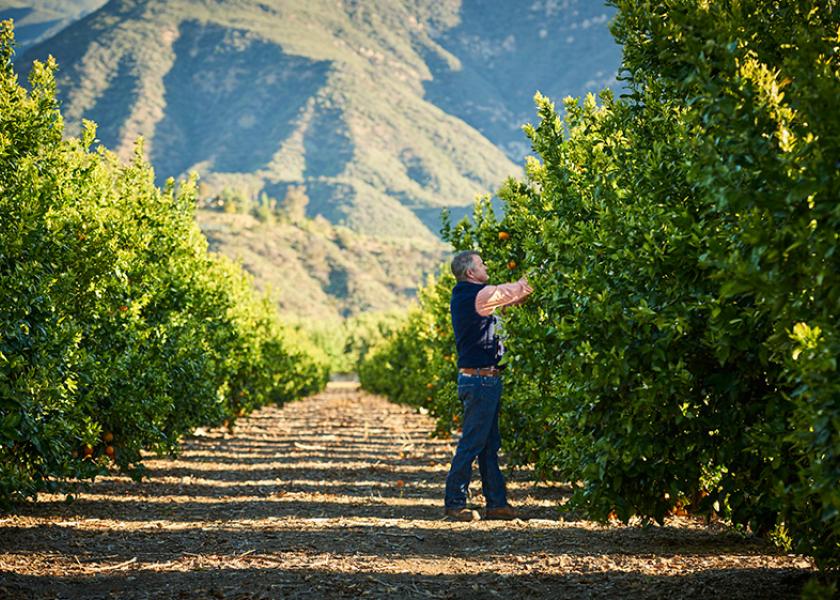Surviving megadrought, Southwest citrus growers manage water wisely

Growing fruit in the arid Southwest will keep you on your toes. Not only do California and Arizona citrus growers face the challenge of growing fruit profitably in shifting markets, but drought conditions in the southwestern U.S. continue to worsen and affect irrigation. Compounded with the recent account of fellow citrus growers in Florida suffering devastating crop loss due to Hurricane Ian, it’s reasonable to assume that there are many questions weighing heavy in growers’ minds at the start of this winter citrus season.
Navigating drought conditions
Looking ahead to 2023, extreme weather is impacting not only growers recovering from the hurricane in the Southeast, but drought conditions in the Southwest continue to worsen, with no end in sight. The megadrought that grips the Southwest has broken yet another record, according to a study just released from science journal, Nature.
According to the study, 2021’s “exceptional drought severity” tacked on another year to the prolonged, 22-year drought. From 2000 to 2022, the drought has marked the driest period in the Southwest since at least 800 A.D. with the effects of climate change intensifying the severity and adding new challenges to recover from dry conditions.
One major consequence of the drought is reduced water available for irrigating Southwest citrus crops. The Colorado River Basin which irrigates much of the Southwest, including California and Arizona, is currently weathering the effects of the megadrought, according to the Arizona Department of Water Resources. Severe drought conditions mean reduced levels in Lake Mead, located on the Arizona-Nevada border, which provides water for seven states. Drought conditions also reduce river flows along with the Lower Colorado River running along the Arizona-California border, further stressing the overallocated Colorado River.
Farmers in California and Arizona are experiencing the driest conditions in the basin and mounting water restrictions are expected to continue well into the future. According to the U.S. Secretary of the Interior, both Lake Mead and Lake Powell in northern Arizona are approaching critical elevation levels and will require unprecedented management actions to protect infrastructure in both the Upper (Colorado, New Mexico, Utah and Wyoming) and Lower (Arizona, California, Nevada and parts of Mexico) Colorado River Basins. The shortage assessment is based on the elevation of Lake Mead, which is dependent upon releases from Lake Powell.
Responding to these extreme conditions, The Central Arizona Project, a canal system built by the federal government for Arizona farmers to tap into excess Colorado River water, implemented drought mitigation reductions for Arizona agricultural users in 2022, reducing available Colorado River water by over 60%. Central Arizona Project water users have met nearly all their targeted, Tier 1 level reductions in Arizona, but current projections for CAP users indicate that escalating to a higher, Tier 2 shortage level in 2023 will be necessary.
This means continuing deep cuts to agricultural water available, as well as increasing restrictions to include reducing water available to municipal, industrial and tribal water users.

In California, low levels on the Colorado River are compounded by reduced snowpack in the Sierra Nevada, which supplies surface water for much of the Central Valley. According to the California Department of Water Resources, milder temperatures and limited precipitation are causing early and even mid-winter snow melt. This April, the surface water reached only 38% of its historic average water level.
The most recent drought in California that began in 2020, worsened when California's Central Valley faced its driest January and February in recorded history. The seasonal pattern that worked so well to supply water in past years relied on storing water from mountain snowpack to release slowly during California’s dry spring and summers. These snowpack reserves are no longer guaranteed.
“This significant decrease in snowpack has a direct impact on water supply for Californians,” according to the California Department of Water Resource. “The warming climate already is making it harder to grow food in some parts of the world, like California, which depends on snow piling up in the Sierra Nevada mountains for irrigation. Climate models predict more serious disruption to global agriculture a few decades in the future because of shifting rainfall and extreme weather.”
Responsible water management
Sunkist has dedicated careful long-term planning as a key component of its sustainability plan, according to Christina Ward, senior director of global marketing at Sunkist Growers. “We remain focused as water supply will continue to be a concern going forward, and labor increases and cost pressures continue to put added pressure on our industry,” said Ward.
Related news: Resourceful farmers adapt to a changing climate, finding new ways to combat pests and conserve water
“Responsible water management is key,” Ward continued. “Citrus farmers have long used the most advanced technology with soil moisture monitors and micro-sprinklers to water trees for just what it needs.”
At Bee Sweet Citrus, “water supplies have been tight, but adequate,” said Keith Watkins, president of farming at Bee Sweet Citrus. “Costs for producing and watering this year’s crop are substantially higher than historic [averages].”
Growers constantly ask themselves “how do I change our practices to accommodate this?” according to Edgar Gutierrez, vice president of farming operations at Limoneira, a lemon grower with ranches in both California and Arizona. What’s more, Gutierrez says responding quickly to changing prices and “scarcity of water, fuels and fertilizer” is necessary to stay competitive.
“All of a sudden, a factor in the product you were selling for a certain price changes and you must quickly adapt to be profitable. But changing practices in the field takes time,” said Gutierrez. “One of the biggest challenges in the farming industry is how do we adapt quickly in the cost model, in order to stay efficient?”







